Taking into account the feedback that was given during the consultation, I pushed the graphic elements even further, removed non-essential elements and weaved in a narrative flow to the information of the arts and health programme.

the dream is free, the hustle is sold separately

Taking into account the feedback that was given during the consultation, I pushed the graphic elements even further, removed non-essential elements and weaved in a narrative flow to the information of the arts and health programme.

I started off the brochure project by researching on brochure design and applications of graphic elements.
This book, titled The Best of Brochure Design, offered an insight into the process of making brochures.
I looked into handdrawn illustrations as a reference for its organic and friendly outlook.
I then looked into architectural brochures for their geometrical composition, clean simple lines and efficient use of emphasis.
I was also rather inspired by this brochure taking reference from Mondrian’s composition. Its bold outlines and 3 tone colors resonated strongly with me.
I then went on to research on graphic elements that I could use for my brochure.
The use of media and color interested me; I also wanted to find a way to engage the audience appropriate to the context of Ng Teng Fong hospital.
This use of die cut and fold for a tailor in Australia made me sit up and think about the ways I could make the brochure memorable and convey the associations of arts and health to the audience.
Overall, some of the examples left an indelible impression on me as I began to explore the various ways of incorporating design elements into my brochure.
Draft 1:
The first idea I had for the brochure was incorporating the nurse’s uniform into the brochure. As the attire represented the hospital, I thought it would be able to convey the principles of the Arts and Health programme. During the consultation, Michael and I agreed that incorporating the vest of the volunteers would further enhance the idea of arts collaborating with health; volunteers working with hospital staff to improve the welfare of patients.
The first draft of the brochure was done via grid formatting, and it was clear that there was not enough flow after consulting with Michael. The grid, instead of being a liberating tool, became a limiting factor for the brochure.
The exterior had the following issues:
The interior had the following issues:
When I printed out the first draft of the brochure, I started off with the left flap of the brochure as the front cover. However, as one can see from above there is a misalignment of the “collars” as I used a larger gutter for breathing space on the right flap for indication to flip over.
I sought to resolve those issues in my second and final draft for the brochure.
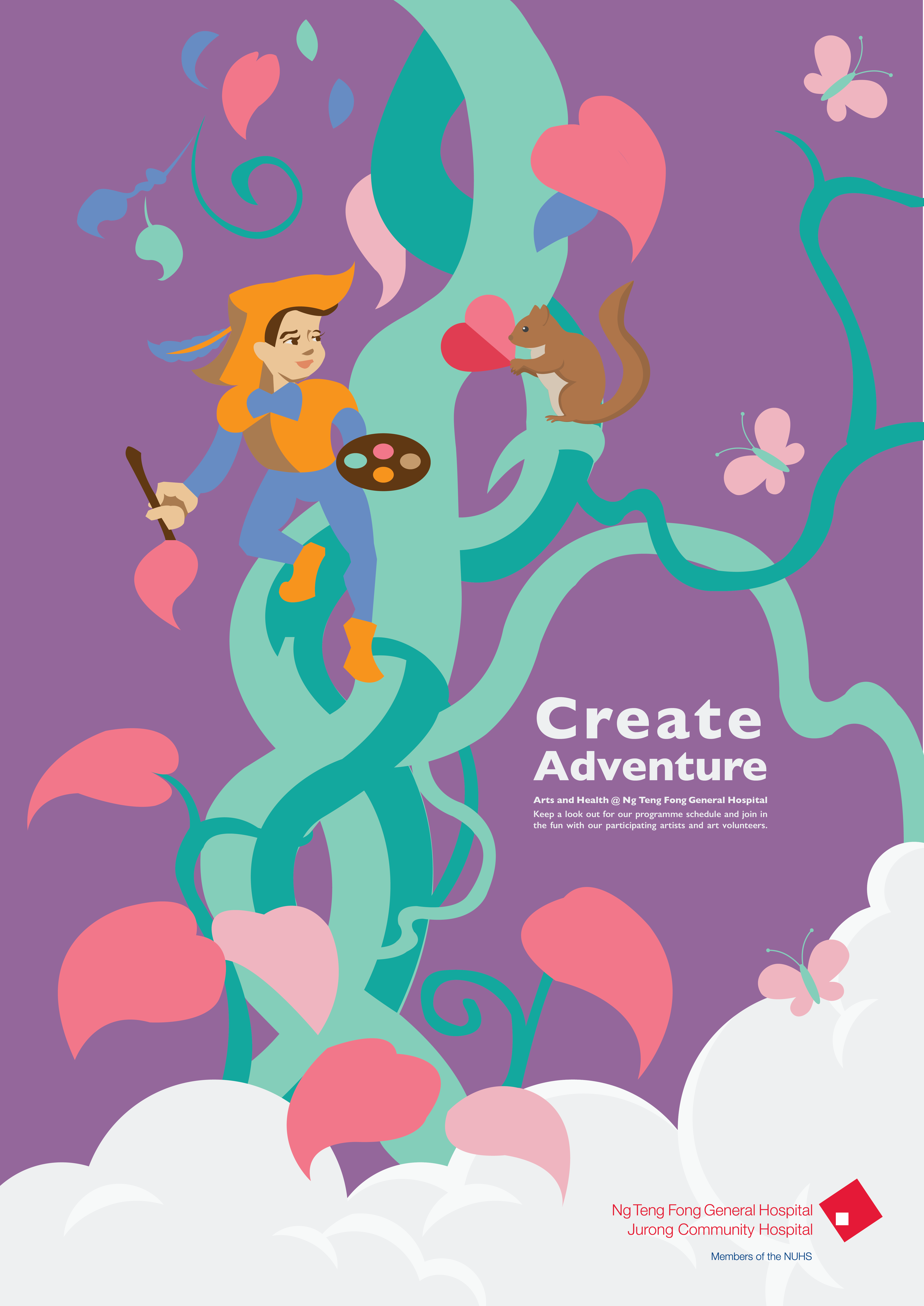
I added more branches laterally across the composition to integrate the text and the art. I chose Gill Sans as it was a san serif type, and was less rigid and formal than the other typefaces that I experimented with. I extended the clouds to the edges, with butterflies near the periphery of the poster. Overall, I think the composition is well balanced after a few rounds of editing. The text integrates well with the art and the overall feel of the poster is serene, yet with an element of excitement and unexpected fun.
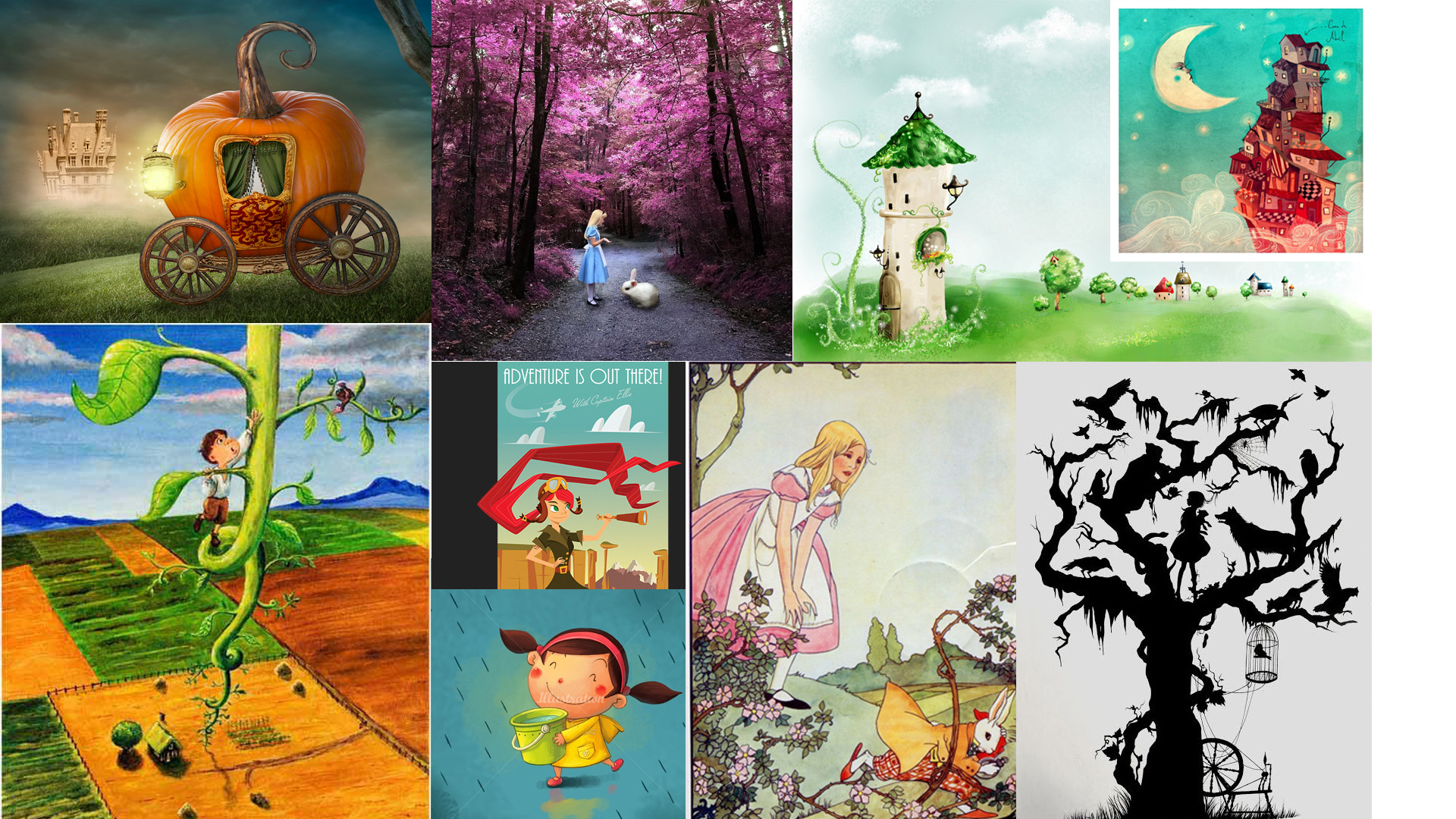
I started off this project with a few moodboards based on a few different themes. I wanted to deviate from the common portrayal of arts in posters, with an element of storytelling.
Moodboard 2: enjoyment
Moodboard 3: fairytale
Thereafter, I came up with drafts of all 3 ideas based on the mindmap i created
Fairytale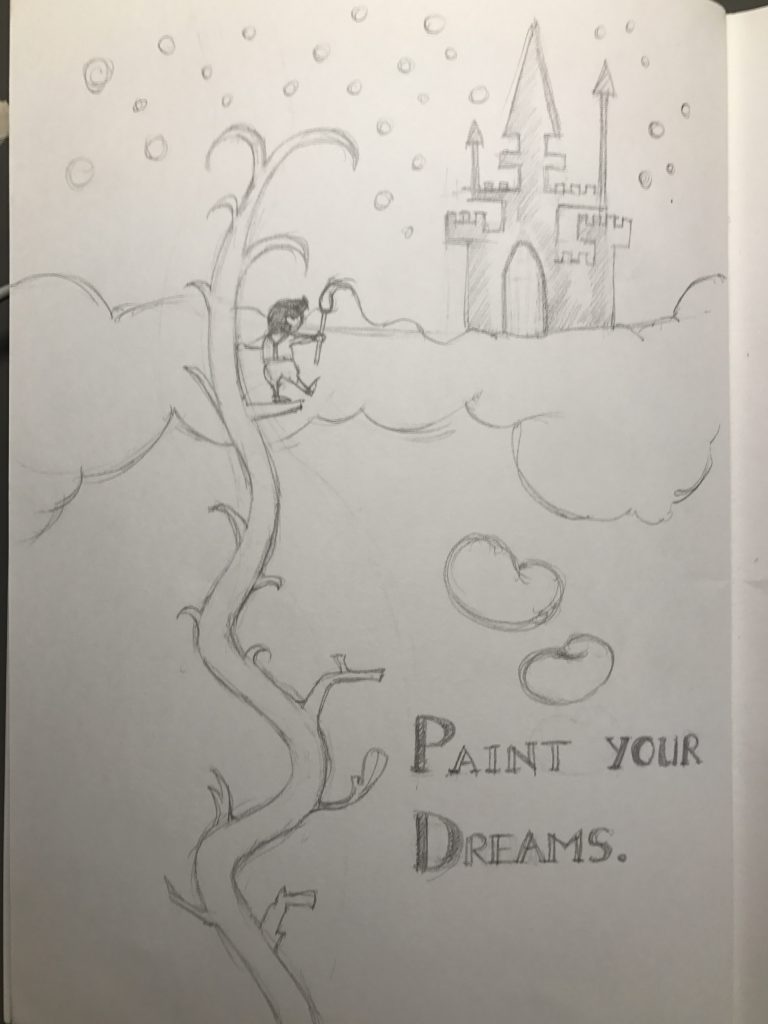
The first draft was too immature, and the visual narrative was quite misleading; is Jack climbing the beanstalk to visit the hospital? Or is he painting a heaven? With these questions in mind, I then decided to create a cleaner composition.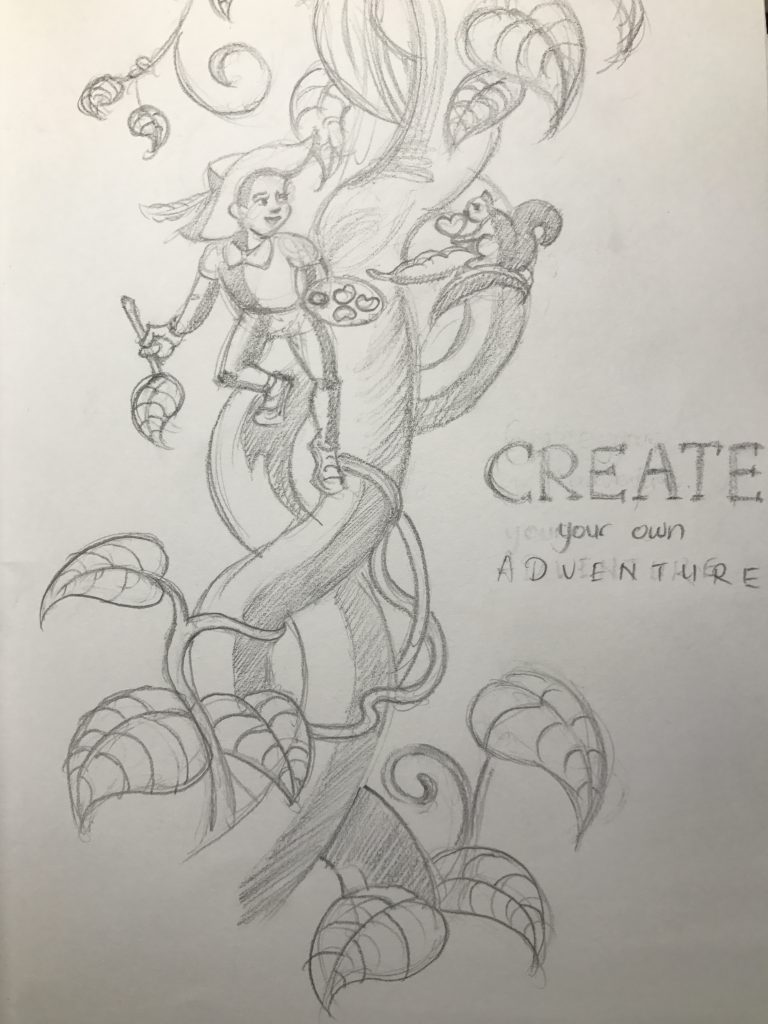
I decided on the fairytale as a theme for my poster. Using Jack and the Beanstalk as a reference point, I used illustration to portray the idea of “creating your own adventure”, with the patient or volunteer identifying with the character Jack painting a mural that comes alive, filled with passion and immersing himself into the environment of the hospital.
This is the composition before I added in colour. I felt that there was a flow to the image, with the overlapping forms and the visual narrative. The font I initially chose was Bebas Neue, but I eventually realised it was too geometric for a fun composition.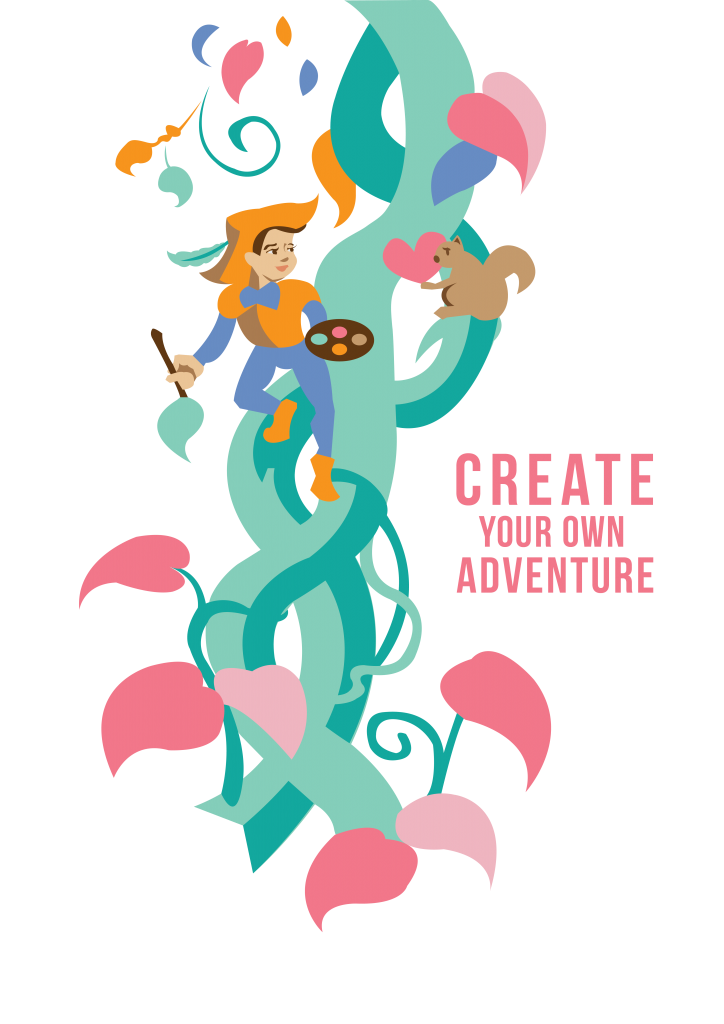
This was draft 1 of the poster. (the colour is a bit off after uploading jpeg to OSS) The feedback I got was that the background was a bit too dull. I decided to explore more exciting colours for the background. I decided to stick to the current narrative as I liked the idea of the squirrel having been painted by Jack, decides to give back in love. In terms of the composition, the type also does not meld well with the art, which was something to consider. The type was too big and rather distracting. Again, the serif fonts felt too formal for the informal design.

I started off doing some research into vintage ads because I liked the simplistic style and technicolor aesthetics, and hoped to find some inspiration. I found an illustration magazine and among its pages were the following posters.
I liked the muted color palette and the simple, clean forms of the artwork. It was direct and sent a clear message.
I like this poster the most because of its composition, art direction and message.
The poster’s message is simple: wear and share your Nike Airmax sneakers. Being a sneakerhead, I like the way Nike has implied a community. Indeed, the brand builds communities around sports. The poster does exactly that.
By using a limited color palette with teal, red, white and black, it is able to create an immediate visual impact with space-themed aesthetics. With balls in orbit, one can easily interpret them as footballs, tennis balls etc. It has enough ambiguity to be playful. The shoe is smack in the centre, like the sun, pulling everything into its orbit.
This is the essence of the poster – Airmax is the centre of the universe. And the emotion it elicits is that of awe and amusement; that something worn on the feet can be celebrated in such a way.
The big bold custom typeface enhances legibility the poster. Together with vector illustration, flat bold colours and good contrast, it generates visual interest with the space-themed illustration first before giving clarity in the big bold type.
Overall, I feel that the playful approach makes this a very effective ad as it conveys the energy of the brand (Just Do It) as well as the call to action (AIRMAX DAY). The execution was bold and forthcoming, combining a limited palette with a bold illustration style and even bolder typography.
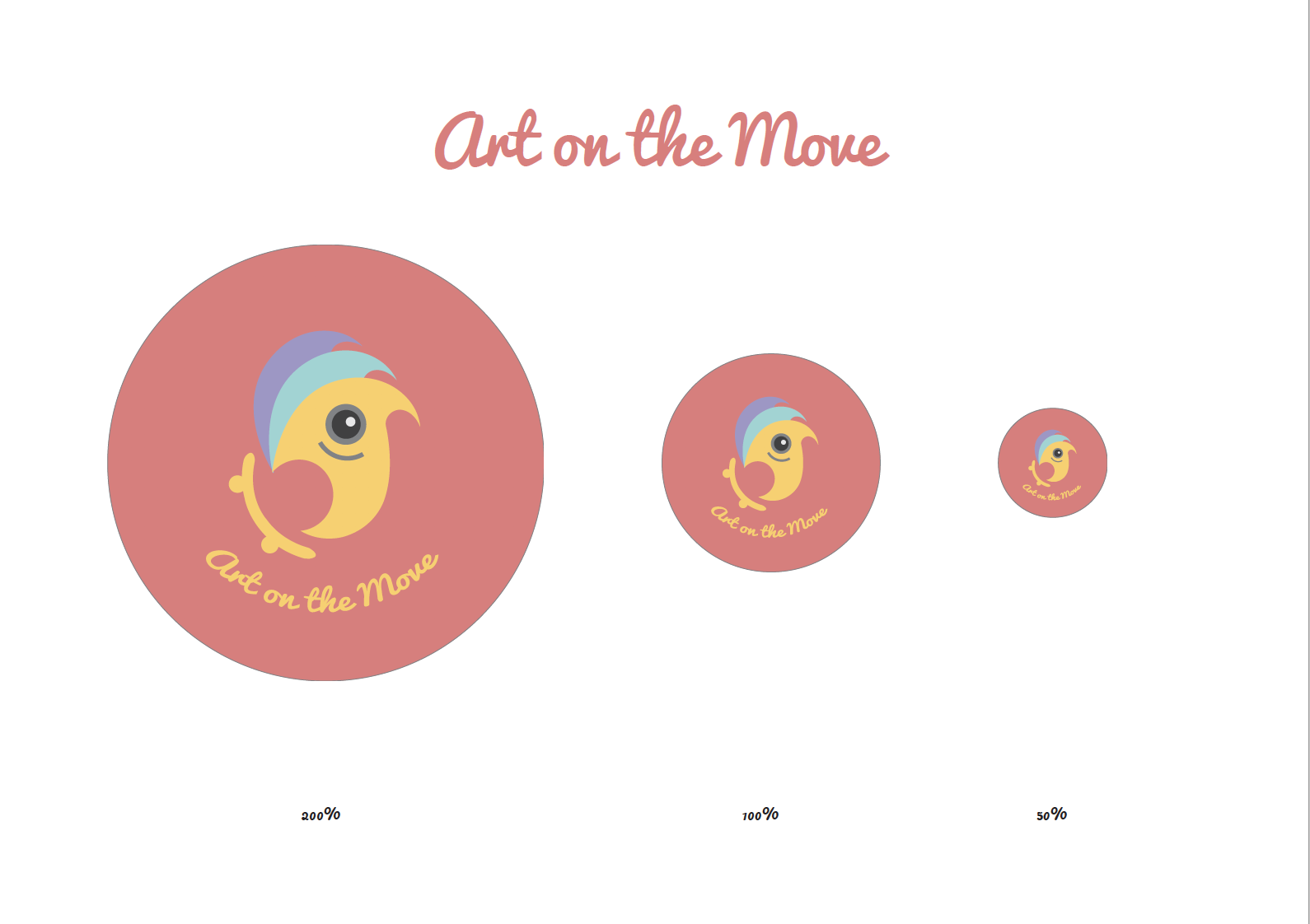
From the previous 2 designs, I reduced the number of elements in the logo and sought to combine both ideas. The biggest challenge I faced were to incorporate elements of the previous 2 drafts into the final versions.
I started working with a pink background as i felt it would complement well with the teal vests given to volunteers. The lighthouse made way for a more abstract form that resembled the sails of a ship. I morphed the pencil head of the previous logoform into the tip of a brush. I retained the eye in the logoform to make it come alive, imbuing it with a life of its own. This created movement and dynamism in the logoform.
In greyscale, the colours are more muted, but it was still very visible and contrasted well with the background. The form can be analysed objectively from colour, and the way the brushtip rode the skateboard with an upward movement made it fun.
I made another draft in a different color, without the eye.
This design looks less ambiguous after the removal of the eye, and thus won’t be misconstrued as a bird. As blue is the color of wisdom and reliability, it will complement well with the bold, energetic orange, pink and purple of the logoform and type, symbolising vitality.
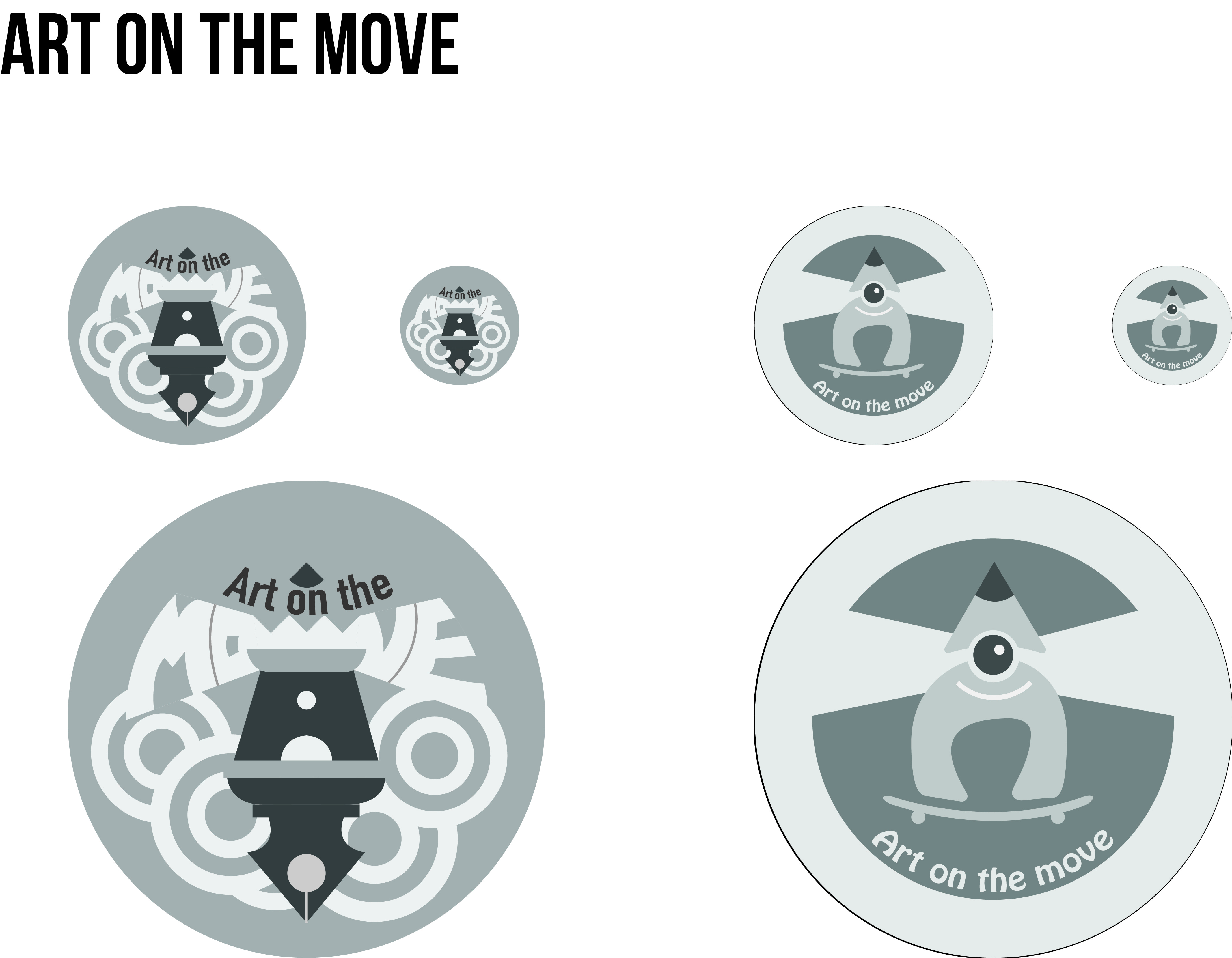
The initial research brought me to look at 3 predominant ideas: the adventurer, the spirit animal and the lighthouse.
Adventurer:
Although I managed to mould it into a more ambiguous form, it did not feel complete. The feedback I received also included the fact that some of the final versions of the sketches were too complicated.
I realised the potential of these batch of sketches via the consultation, but perhaps because of the choice of animals they looked more like a Tesla logo than an Art on the Move logo. It was time to move on. 80/20 rule.
I received the most positive feedback on this batch of sketches. The lighthouse was a beacon of hope to patients and volunteers, and the symbolism was carried through with clarity. The top 2 sketches i.e. Minion and Lighthouse pen/pencil were digitised on Illustrator.
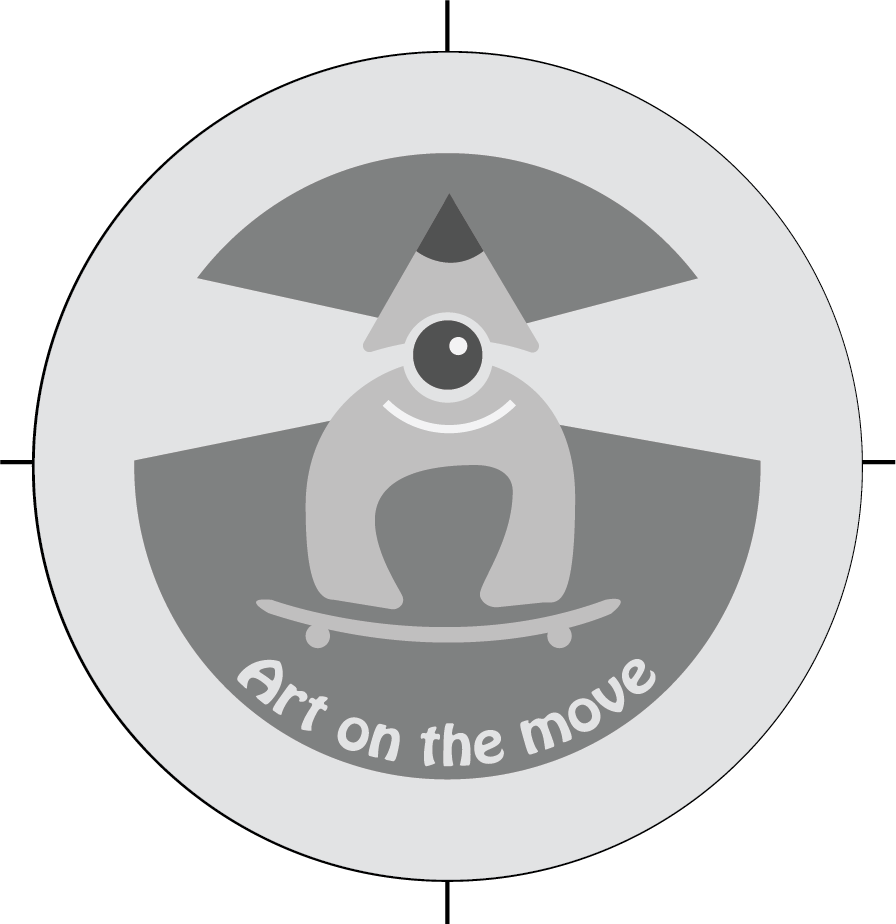
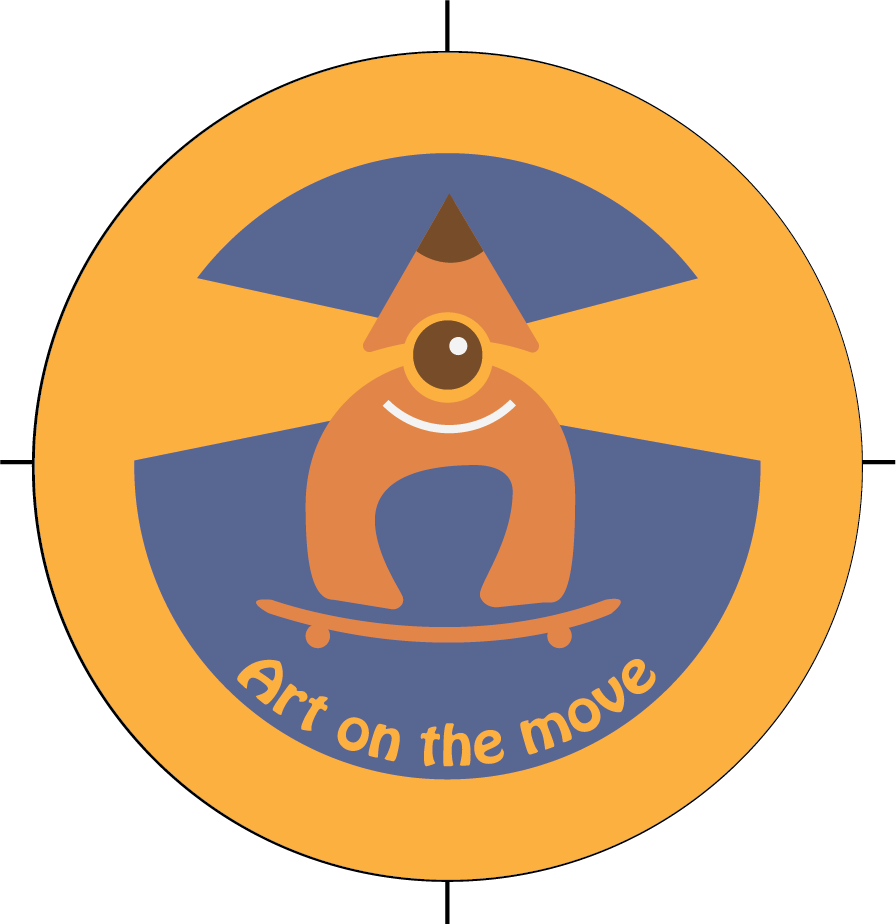
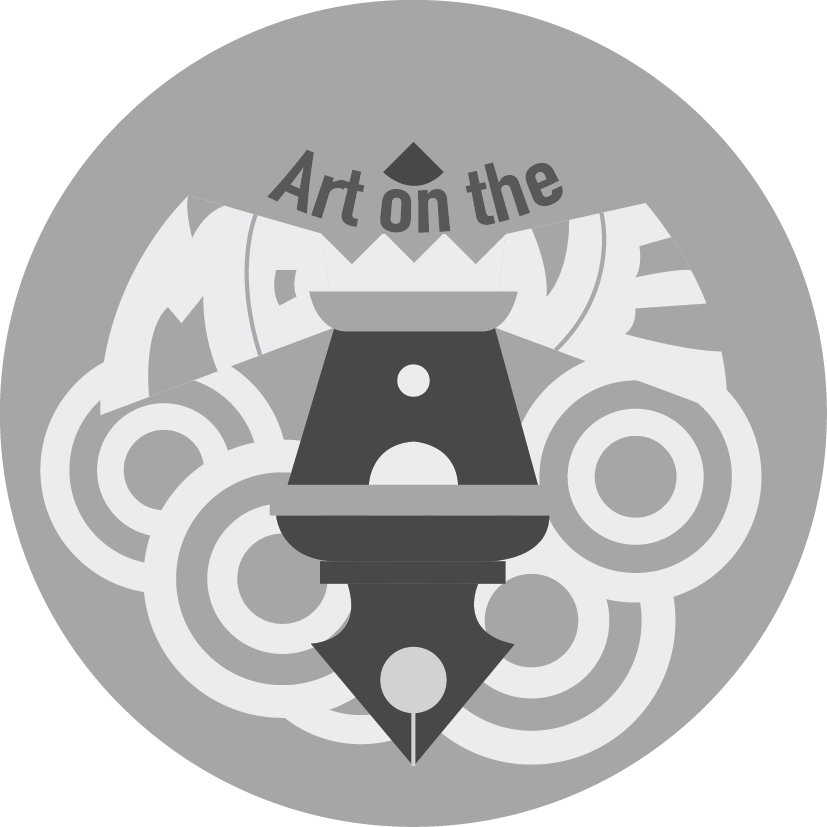
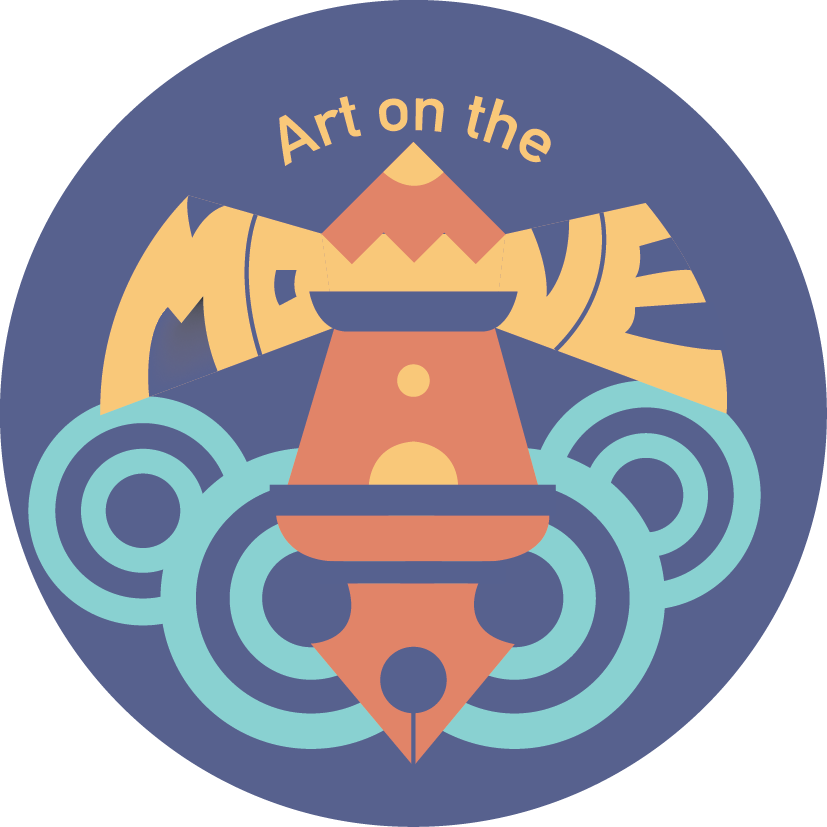
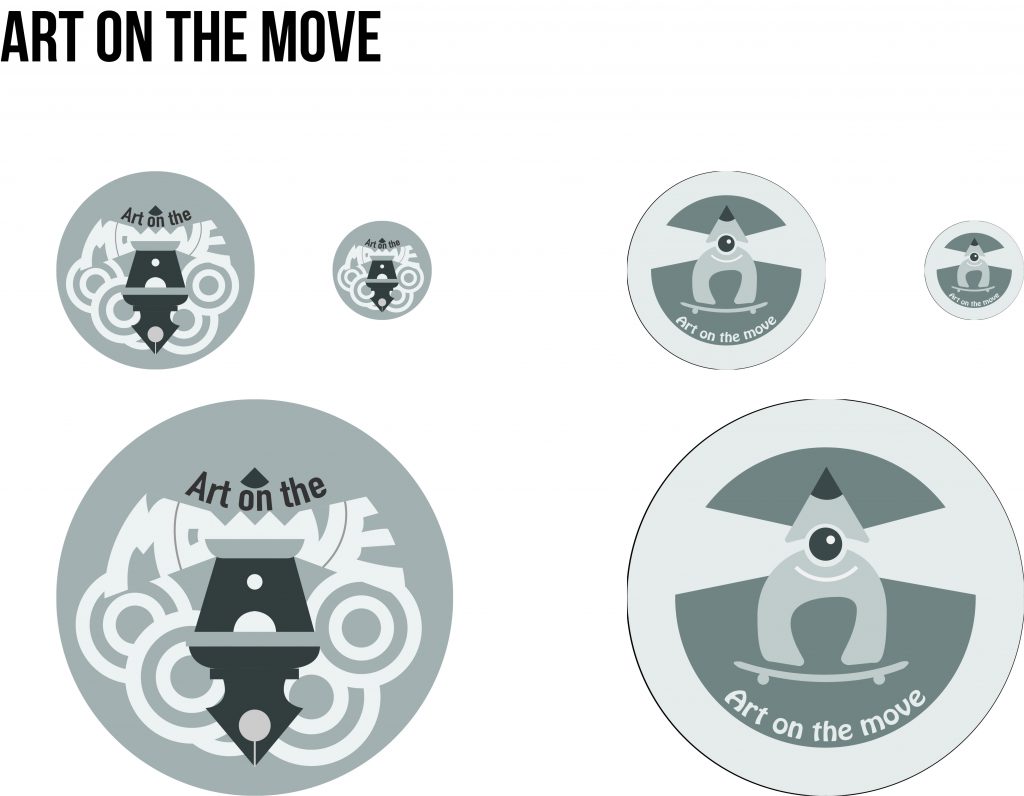
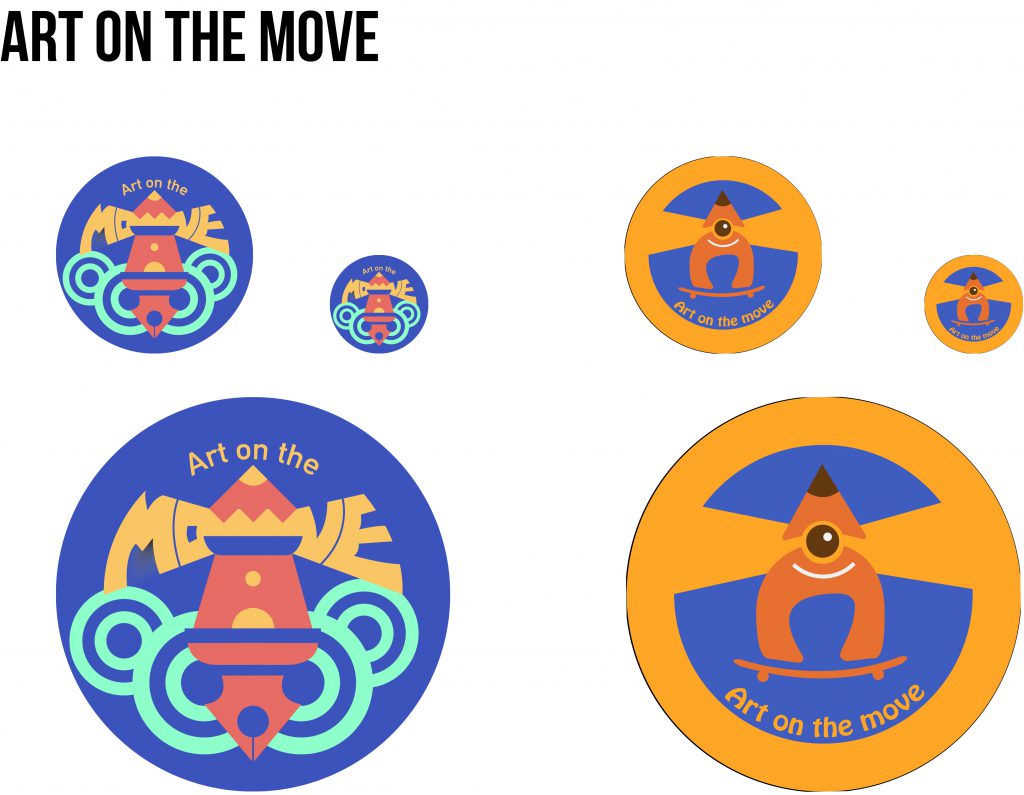
Honestly I have no idea why there seems to be a difference in tones in the individual batches and the ones on the spread. The individual badges’ colours are the ones with the accurate colours. I went for more muted colours that were complementary, giving them a subtle contrast, retaining the A letterform while playing with imagery and symbolism. I look forward to refining these 2 ideas.

We began our visit to Ng Teng Fong hospital for our assignment brief prior to embarking on our project. Taking a look around the hospital, I noticed the hospital liked expressive, vibrant illustrations with a touch of nostalgia.
These were some of the paintings and illustrations that adorned the walls of the hospital. Batik and sewing were mediums that offered a lighter mood to patients. Venturing into the wards, I liked the simplicity and elegance of its architecture, its gentle curves contrasted with the rhythm of the steel beams. I wondered what would complement such an environment, perhaps even contrast it, since art in this case served at the behest of the patients’ health.
Design Aims: Designing a button badge that requires us to reflect the values of the Art on the Move programme by Ng Teng Fong hospital, a voluntary effort to decorate the hospital with murals and art that reflects the cultural identity of the patients, as well as to build upon the existing body of work that is currently in the hospital. This will give the volunteers a sense of belonging to the organization and a sense of pride in what they do, keeping the badge as a representation of their efforts. Equally important, it will aid identification of the volunteers.
Target Audience: Volunteers of NTF hospital under the Art on the Move programme
Keywords: The main themes that we came up with during the class brainstorming session were compassion, love, excitement, hope, inspiring, life, peaceful, adventure, transformation and vitality.
Based on the aforementioned keywords, I created a mood board that summarised all the different buzzwords.
I began to whittle things down from the bigger picture to the more specific details.
CONCEPT 01: Embarking on Adventure
Rationale: As the badge is designed for the volunteers, our direct clients are the volunteers and indirectly the patients. Thus, a sense of exploration and artistic daring should be present on the badge. Without a sense of adventure, the programme would be clinical and sterile. The badge thus acts as a conduit to highlight the adventure both volunteers and patients will embark on, creating and receiving art that is bold and engaging, enhancing the environment of the hospital in the process.
Keywords: Vibrant, fun, excitement, outgoing, bold, colourful, journey, setting sail
CONCEPT 02: Beacon of Hope
Rationale: The spirit of volunteerism is alive and well, with volunteers ushering the patients through their stay in the hospital and creating a place of safety and hopeful recovery. The volunteers stand as beacons of hope, their artworks engaging and delighting their benefactors and bringing added joy to their lives. These artworks bring peace to the chaos and uncertainty that may surround a patient who awaits treatment or recovering slowly from a debilitating illness.
Keywords: Light, lighthouse, peace, safety, zen, tranquility, purpose
CONCEPT 03: Spirit Animal
Rationale: Spirit animals represent certain characteristics that may lend great meaning to the spirit of volunteerism. Through the badge, the spirit animal may invoke certain ideals or values that the volunteers shall represent, e.g. strength in adversity (elephant) and kindness (deer). Though different volunteers may have different personalities, they all represent the same thing to patients, a source of strength and comfort through times of uncertainty. Art on the Move then becomes an animal that is constantly on the move, travelling through the savannahs of life, documenting, expressing and performing.
Keywords: elephant, deer, strength, protection, stability, gentle, compassion
Before embarking on our first VC project for this semester, I did some research on logos and identity.

I chose this book as it had a wide range of logos created by notable designers. Companies like NBC network and Martha Stewart co. were notable clients. It also included the thought process that went behind the ideation.
This page illustrated the different types of logos and possibilities of each type.
This page defined the logo and its purpose.
I like the designer’s approach to break down the logo and create something new out of the deconstructed form. It was clean, minimal and effective.
This caught my attention as I realised the possibilities of scaling up a logo into an abstract watermark. Its versatility appealed to me as much as its Impressionistic style aka Georges Seurat.
The playfulness of this brand is unique; the logotype appeals just as much as Pacman does. The color scheme is also bright and cheery, with the added design possibility of converting it into an exclamation mark.
I like the use of font as well as negative space in this logotype. The 3-dimentional logotype also looks good as a backdrop, reiterating the dynamism of this company.
The color scheme works, along with the contrast between navy blue and white type.
This is one of my favourite packaging designs in this book as it creates an image in consumers’ minds. It creates an evocative mood.
The semi abstract forms have a cutout effect that showcases the rawness and expressiveness of the brand and its event, similar to the Apple ipod ads in the early 2000s.
This VISA moodboard shows how colour alone can create so many expressions of the brand.
This clipping mask technique can be emulated for a cinematic effect.
Again, a design built out of coloured dots. It seems to reinforce the KISS rule.
One of my favourite brand designs of all time, I love how the brand conveys the classiness of the restaurant effortlessly. The type, subtle curves and motifs makes for a visual treat.
Love the simplicity and imagery associated with these 2 logos.
Love how the grid was used for this poster. The neon vibes rock.
The ideation process for NBC was initially a rainbow before it became a peacock.
Very smart way of looking at things.
Recent Comments